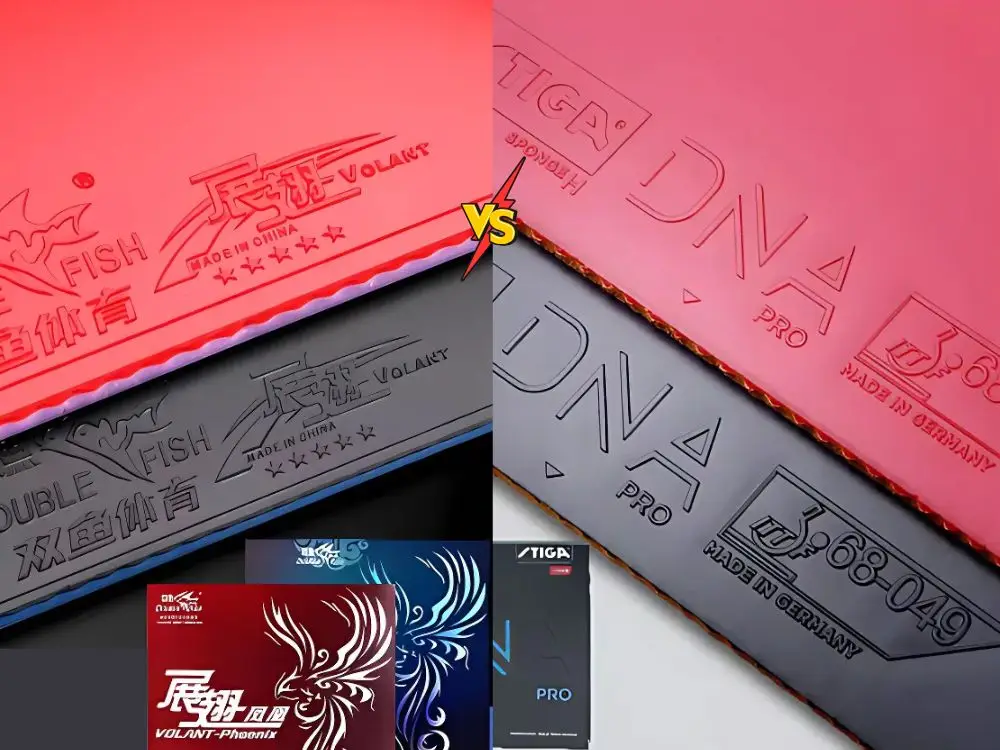Choosing the right table tennis rubber is a game changer literally. Two of the most common types of rubbers are European and Chinese. If you’re confused about which one to pick, this guide breaks down the differences in simple terms to help you make the best decision for your playing style and goals.
What Are European and Chinese Rubbers?
European Rubbers
European rubbers are typically manufactured in Germany or Japan by brands like Butterfly, Xiom, Donic, Andro, and Tibhar. They use high-tech sponge technology (often called tensor sponge) that delivers strong catapult effect. These rubbers are known for being bouncy, fast, and grippy rather than sticky.
They are popular among players who want dynamic spin, quick rebounds, and easier power generation.
Chinese Rubbers
Chinese rubbers, made by brands like DHS, Palio, Friendship (729), and Yinhe, have a different feel. They feature a tacky (sticky) topsheet and harder sponge, requiring the player to use more physical effort to generate speed and spin. These rubbers are designed for precision, spin control, and stroke development.
They are often favored by players who want maximum spin and dwell time or prefer Chinese forehand looping technique.
Key Differences Between European and Chinese Rubbers
| Feature | European Rubber | Chinese Rubber |
|---|---|---|
| Topsheet | Grippy (non-tacky) | Tacky (sticky) |
| Sponge | Soft to medium, bouncy | Hard, dense |
| Power Generation | Easier (catapult effect) | Requires effort and proper stroke |
| Spin Creation | Easier for light brushing | Excellent with full contact technique |
| Control Feel | More forgiving, faster arc | Slower arc, more precision |
| Dwell Time | Shorter, fast release | Longer dwell time for spin loading |
| Looping Style | Compact stroke, fast loop | Full swing loop, high spin potential |
| Maintenance | Easier, less sensitive to dust | Needs frequent cleaning to maintain tack |
| Durability | Medium | High (if maintained properly) |
Which Rubber Is Better for You?
Choose European Rubber if:
- You are a beginner to intermediate player.
- You want rubber that’s easier to control and offers good spin with less effort.
- You prefer bouncy sponge and quick rallies.
- Your technique is still developing.
Choose Chinese Rubber if:
- You are focused on developing strong strokes and spin mechanics.
- You want a high level of precision and dwell time.
- You’re using full arm motion, especially on forehand loops.
- You don’t mind working harder to generate power.
Both types can be excellent, but for different goals. Some advanced players even combine both styles, using Chinese rubber on forehand and European rubber on backhand.
Player Types & Recommendations
| Player Type | Recommended Rubber Type | Reasoning |
|---|---|---|
| Recreational/Casual | European | Easier control and spin without full technique |
| Competitive Beginner | European | More forgiving and fast learning curve |
| Spin-Focused Looper | Chinese | Higher spin potential with proper stroke |
| Quick BH Counter-Hitter | European | Better for punchy backhands and quick rebounds |
| Defensive Chopper | Mixed | Often uses Chinese for tacky control |
Popular Rubber Examples
Here are examples of some commonly used rubbers from each category:
| Rubber Name | Origin | Type | Features |
|---|---|---|---|
| DHS Hurricane 3 Neo | Chinese | Tacky Inverted | Heavy spin, hard sponge, great for forehand loop |
| 729 Super FX | Chinese | Tacky Inverted | Very affordable, great control and tackiness |
| Palio CJ8000 Light | Chinese | Hybrid Tacky | Tacky topsheet with softer sponge, beginner-friendly |
| Butterfly Tenergy 05 | European | Euro Tensor | Bouncy sponge, elite-level looping rubber |
| Xiom Vega Pro | European | Euro Tensor | Grippy, fast arc, easy to loop |
| Donic Bluefire M2 | European | Euro Tensor | High speed and spin, ideal for dynamic play |
Can You Mix Both Rubbers?
Yes, many advanced players mix rubber types for different functions:
Chinese Rubber on Forehand: For powerful, spinny loops with full strokes.
European Rubber on Backhand: For quick, compact strokes and fast blocks.
This hybrid setup offers both precision and responsiveness on each wing, maximizing versatility.
Example: DHS Hurricane 3 Neo (FH) + Tenergy 05 (BH)
Maintenance & Durability
- Chinese rubbers need more attention. The tacky surface attracts dust and must be cleaned with water or rubber cleaner after use.
- Use protective film to maintain tackiness.
- European rubbers are lower maintenance but tend to lose their bounce over time.
- Replace every 6–8 months for optimal performance.
Conclusion
Choosing between European and Chinese rubbers depends on your skill level, goals, and style. European rubbers are great for ease of use, while Chinese rubbers are excellent for precision and spin-focused gameplay.
You don’t have to commit to one or the other. Try both and find what suits your forehand, backhand, and strategy best.


